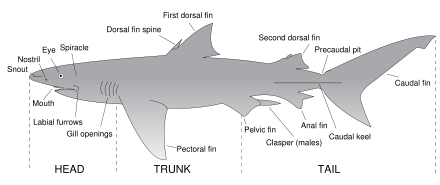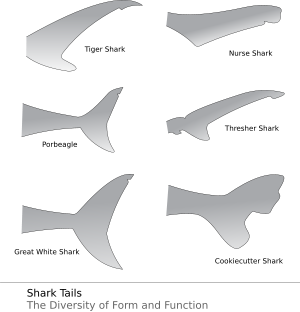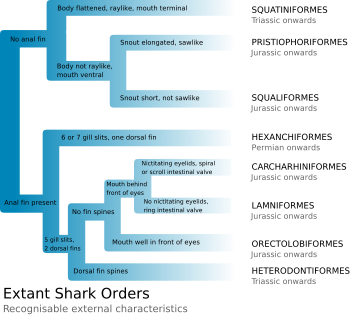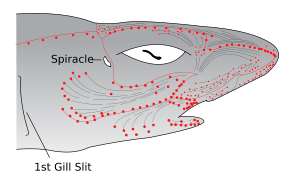Shark
2008/9 Schools Wikipedia Selection. Related subjects: Insects, Reptiles and Fish
| Shark Fossil range: Late Devonian - Recent |
||||||||||||
|---|---|---|---|---|---|---|---|---|---|---|---|---|
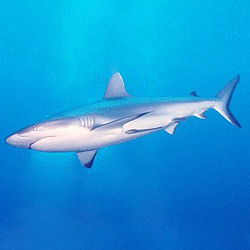 Grey reef shark, Carcharhinus amblyrhynchos
|
||||||||||||
| Scientific classification | ||||||||||||
|
||||||||||||
| Orders | ||||||||||||
|
Carcharhiniformes |
Sharks ( superorder Selachimorpha) are a type of fish with a full cartilaginous skeleton and a streamlined body. They respire with the use of five to seven gill slits. Sharks have a covering of dermal denticles that protect their skin from damage and parasites and improve fluid dynamics; they also have replaceable teeth. Sharks range in size from the small pygmy shark, Euprotomicrus bispinatus, a deep sea species of only 22 centimetres (9 in) in length, to the whale shark, Rhincodon typus, the largest fish, which grows to a length of approximately 12 metres (39 ft) and which, like baleen whales, feeds only on plankton, squid, and small fish through filter feeding. The bull shark, Carcharhinus leucas, is the best known of several species to swim in both salt, freshwater and in deltas.
Physical characteristics
Skeleton
The skeleton of a shark is very different from that of bony fish and terrestrial vertebrates. Sharks and other cartilaginous fish (skates and rays) have skeletons made from rubbery cartilage, a tissue lighter and more flexible than bone.
Like its relatives many rays and skates, the shark's jaw is not attached to the cranium. The jaw's surface, which like the vertebrae and gill arches is a skeletal element that needs extra support due to its heavier exposure to physical stress and need for extra strength, has a layer of unique and tiny hexagonal plates called "tesserae", crystal blocks of calcium salts arranged as a mosaic. This gives these areas much of the same strength found in real and much heavier bony tissue.
The general rule is that there is only one layer of tesserae in sharks, but the jaws of large specimens, such as the bull shark, tiger shark, and the great white shark, have been found to be covered with both two and three layers, and even more, depending on the body size. The jaws of a large white shark even had five layers.
In the rostrum (snout), the cartilage can be spongy and flexible to absorb the power of impacts.
The fin skeletons are elongated and supported with soft and unsegmented rays named ceratotrichia, filaments of elastic protein resembling the horny keratin in hair and feathers.
The inner parts of the males' pelvic fins have been modified to a pair of cigar- or sausage-shaped sex organs known as "claspers," used for internal fertilization.
Respiration
Like other fish, sharks extract oxygen from seawater as it passes over their gills. Shark gill slits are not covered like other fish, but are in a row behind its head. A modified slit called a spiracle is located just behind the eye; the spiracle assists the water intake during respiration and even plays a major role in bottom dwelling sharks, but is also reduced or missing in active pelagic sharks. While moving, water passes through the mouth of the shark and over the gills — this process is known as "ram ventilation". While at rest, most sharks pump water over their gills to ensure a constant supply of oxygenated water. A small subset of shark species that spend their life constantly swimming, a behaviour common in pelagic sharks, have lost the ability to pump water through their gills. These species are obligate ram ventilators and would presumably asphyxiate if unable to stay in motion. (Obligate ram ventilation is also true of some pelagic bony fish species.)
The respiration and circulation process begins when deoxygenated blood travels to the shark's two-chambered heart. Here the blood is pumped to the shark's gills via the ventral aorta artery where it branches off into afferent brachial arteries. Reoxygenation takes place in the gills and the reoxygenated blood flows into the efferent brachial arteries, which come together to form the dorsal aorta. The blood flows from the dorsal aorta throughout the body. The deoxygenated blood from the body then flows through the posterior cardinal veins and enters the posterior cardinal sinuses. From there blood enters the ventricle of the heart and the cycle repeats.
Buoyancy
Unlike bony fish, sharks do not have gas-filled swim bladders for buoyancy. Instead, sharks rely on a large liver, filled with oil that contains squalene. The buoyant liver may constitute up to 30% of their body mass. Its effectiveness is limited, so sharks employ dynamic lift to maintain depth and sink when they stop swimming. Sandtiger sharks are also known to gulp air from the surface and store it in their stomachs, using the stomach as a swim bladder
Because of this, most sharks need to constantly swim in order to breathe and can't sleep very long, if at all, or they will sink. However certain shark species, like the nurse shark, have spiracles that force water across their gills allowing them for stationary rest on the ocean bottom.
Some sharks, if inverted or stroked on the nose, enter a natural state of tonic immobility. Researchers have used this condition to handle sharks safely..
Osmoregulation
In contrast to bony fish, the blood and other tissue of sharks and Chondrichthyes in general is isotonic to their marine environments because of the high concentration of urea and trimethylamine N-oxide (TMAO), allowing them to be in osmotic balance with the seawater. This adaptation prevents most sharks from surviving in fresh water, and they are therefore confined to a marine environment. A few exceptions to this rule exist, such as the bull shark, which has developed a way to change its kidney function to excrete large amounts of urea. When a shark dies the urea is broken down to ammonia by bacteria — because of this, the dead body will gradually start to smell strongly of ammonia.
Teeth
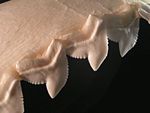
The teeth of carnivorous sharks are not attached to the jaw, but embedded in the flesh, and in many species are constantly replaced throughout the shark's life; some sharks can lose 30,000 teeth in a lifetime. All sharks have multiple rows of teeth along the edges of their upper and lower jaws. New teeth grow continuously in a groove just inside the mouth and move forward from inside the mouth on a "conveyor belt" formed by the skin in which they are anchored. In some sharks rows of teeth are replaced every 8–10 days, while in other species they could last several months. The lower teeth are primarily used for holding prey, while the upper ones are used for cutting into it. The teeth range from thin, needle-like teeth for gripping fish to large, flat teeth adapted for crushing shellfish.
Tails
The tails (caudal fins) of sharks vary considerably between species and are adapted to the lifestyle of the shark. The tail provides thrust and so speed and acceleration are dependent on tail shape. Different tail shapes have evolved in sharks adapted for different environments. Sharks possess a heterocercal caudal fin in which the dorsal portion is usually noticeably larger than the ventral portion. This is due to the fact that the shark's vertebral column extends into that dorsal portion, allowing for a greater surface area for muscle attachment which would then be used for more efficient locomotion among the negatively buoyant cartilaginous fishes. This is in contrast to the bony fishes, class osteichthyes, which possess a homocercal caudal fin.
The tiger shark's tail has a large upper lobe which delivers the maximum amount of power for slow cruising or sudden bursts of speed. The tiger shark has a varied diet, and because of this it must be able to twist and turn in the water easily when hunting, whereas the porbeagle, which hunts schooling fish such as mackerel and herring has a large lower lobe to provide greater speed to help it keep pace with its fast-swimming prey. It is also believed that sharks use the upper lobe of their tails to counter the lift generated by their pectoral fins.
Some tail adaptations have purposes other than providing thrust. The cookiecutter shark has a tail with broad lower and upper lobes of similar shape which are luminescent and may help to lure prey towards the shark. The thresher feeds on fish and squid, which it is believed to herd, then stun with its powerful and elongated upper lobe.
Dermal denticles
Unlike bony fish, sharks have a complex dermal corset made of flexible collagenous fibres and arranged as a helical network surrounding their body. This works as an outer skeleton, providing attachment for their swimming muscles and thus saving energy. In past days the sharks skin has been used as sandpaper.
Their dermal teeth give them hydrodynamic advantages as they reduce turbulence when swimming.
Body temperature
A few of the larger species, such as the shortfin mako, Isurus oxyrinchus, and the great white, are mildly homeothermic; that is: they are able to maintain their body temperature above the surrounding water temperature. This is possible because of the presence of the suprahepatic rate, a counter current exchange mechanism that reduces the loss of body heat. Muscular contraction also generates a mild amount of body heat. However, this differs significantly from true homeothermy, as found in mammals and birds, in which heat is generated, maintained, and regulated by metabolic activity.
Lifespan
Maximum shark ages vary by species. Most sharks live for 20 to 30 years, while the spiny dogfish lives a record lifespan of more than 100 years. Whale sharks (Rhincodon typus) have been hypothesized to also live over 100 years.
Etymology
Until the 16th century, sharks were known to mariners as "sea dogs". According to the OED the name "shark" first came into use after Sir John Hawkins' sailors exhibited one in London in 1569 and used the word to refer to the large sharks of the Caribbean Sea, and later as a general term for all sharks. The name may have been derived from the Yucatec Maya word for shark, xook, pronounced [ʃoːk].
Evolution
Evidence for the existence of sharks extends back over 450–420 million years, into the Ordovician period, before land vertebrates existed and before many plants had colonised the continents. All that has been recovered from the first sharks are some scales. The oldest shark teeth are from 400 million years ago. The first sharks looked very different from modern sharks. The majority of the modern sharks can be traced back to around 100 million years ago.
Mostly only the fossilized teeth of sharks are found, although often in large numbers. In some cases pieces of the internal skeleton or even complete fossilized sharks have been discovered. Estimates suggest that over a span of a few years a shark may grow tens of thousands of teeth, which explains the abundance of fossils. As the teeth consist of calcium phosphate, an apatite, they are easily fossilized.
Instead of bones, sharks have cartilagenous skeletons, with a bone-like layer broken up into thousands of isolated apatite prisms. When a shark dies, the decomposing skeleton breaks up and the apatite prisms scatter. Complete shark skeletons are only preserved when rapid burial in bottom sediments occurs.
Among the most ancient and primitive sharks is Cladoselache, from about 370 million years ago, which has been found within the Paleozoic strata of Ohio, Kentucky and Tennessee. At this point in the Earth's history these rocks made up the soft sediment of the bottom of a large, shallow ocean, which stretched across much of North America. Cladoselache was only about 1 m long with stiff triangular fins and slender jaws. Its teeth had several pointed cusps, which would have been worn down by use. From the number of teeth found in any one place it is most likely that Cladoselache did not replace its teeth as regularly as modern sharks. Its caudal fins had a similar shape to the great white sharks and the pelagic shortfin and longfin makos. The discovery of whole fish found tail first in their stomachs suggest that they were fast swimmers with great agility.
From about 300 to 150 million years ago, most fossil sharks can be assigned to one of two groups. One of these, the Acanthodii, was almost exclusive to freshwater environments. By the time this group became extinct (about 220 million years ago) they had achieved worldwide distribution. The other group, the hybodonts, appeared about 320 million years ago and was mostly found in the oceans, but also in freshwater.
Modern sharks began to appear about 100 million years ago. Fossil mackerel shark teeth occurred in the Lower Cretaceous. One of the most recent families of sharks that evolved is the hammerhead sharks (family Sphyrnidae), which emerged in Eocene. The oldest white shark teeth date from 60 to 65 million years ago, around the time of the extinction of the dinosaurs. In early white shark evolution there are at least two lineages: one with coarsely serrated teeth that probably gave rise to the modern great white shark, and another with finely serrated teeth and a tendency to attain gigantic proportions. This group includes the extinct Megalodon, Carcharodon megalodon, which like most extinct sharks is only known from its teeth and a few vertebrae. This shark could grow to more than 16 metres (52 ft) long and is recognized as the biggest known carnivorous fish to have ever existed. Fossil records reveal that this shark preyed upon whales and other large marine mammals.
It is believed that the immense size of predatory sharks such as the great white may have arisen from the extinction of the dinosaurs and the diversification of mammals. It is known that at the same time these sharks were evolving some early mammalian groups evolved into aquatic forms. Certainly, wherever the teeth of large sharks have been found, there has also been an abundance of marine mammal bones, including seals, porpoises and whales. These bones frequently show signs of shark attack. There are hypotheses that suggest that large sharks evolved to better take advantage of larger prey.
Classification
Sharks belong to the superorder Selachimorpha in the subclass Elasmobranchii in the class Chondrichthyes. The Elasmobranchii also include rays and skates; the Chondrichthyes also include Chimaeras. It is currently thought that the sharks form a polyphyletic group: in particular, some sharks are more closely related to rays than they are to some other sharks.
There are more than 360 described species of sharks split across eight orders of sharks, listed below in roughly their evolutionary relationship from more primitive to more modern species:
- Hexanchiformes: Examples from this group include the cow sharks, frilled shark and even a shark that looks on first inspection to be a marine snake.
- Squaliformes: This group includes the bramble sharks, dogfish and roughsharks, and prickly shark.
- Pristiophoriformes: These are the sawsharks, with an elongated, toothed snout that they use for slashing the fish that they eat.
- Squatiniformes: Also known as angel sharks, they are flattened sharks with a strong resemblance to stingrays and skates.
- Heterodontiformes: They are generally referred to as the bullhead or horn sharks.
- Orectolobiformes: They are commonly referred to as the carpet sharks, including zebra sharks, nurse sharks, wobbegongs and the whale shark.
- Carcharhiniformes: These are commonly referred to as the groundsharks, and some of the species include the blue, tiger, bull, grey reef, blacktip reef, Caribbean reef, blacktail reef, whitetip reef and oceanic whitetip sharks (collectively called the requiem sharks) along with the houndsharks, catsharks and hammerhead sharks. They are distinguished by an elongated snout and a nictitating membrane which protects the eyes during an attack.
- Lamniformes: They are commonly known as the mackerel sharks. They include the goblin shark, basking shark, megamouth shark, the thresher sharks, shortfin and longfin mako sharks, and great white shark. They are distinguished by their large jaws and ovoviviparous reproduction. The Lamniformes include the extinct megalodon, Carcharodon megalodon.
Reproduction
The sex of a shark can be easily determined. The males have modified pelvic fins which have become a pair of claspers. The name is somewhat misleading as they are not used to hold on to the female, but fulfill the role of the mammalian penis.
Mating has rarely been observed in sharks. The smaller catsharks often mate with the male curling around the female. In less flexible species the two sharks swim parallel to each other while the male inserts a clasper into the female's oviduct. Females in many of the larger species have bite marks that appear to be a result of a male grasping them to maintain position during mating. The bite marks may also come from courtship behaviour: the male may bite the female to show his interest. In some species, females have evolved thicker skin to withstand these bites.
Sharks have a different reproductive strategy from most fish. Instead of producing huge numbers of eggs and fry (a strategy which can result in a survival rate of less than 0.01%), sharks normally produce around a dozen pups (blue sharks have been recorded as producing 135 and some species produce as few as two). These pups are either protected by egg cases or born live.
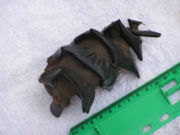
There are three ways in which shark pups are born:
- Oviparity - Some sharks lay eggs. In most of these species, the developing embryo is protected by an egg case with the consistency of leather. Sometimes these cases are corkscrewed into crevices for protection. The mermaid's purse, found washed-up on beaches, is an empty egg case. Oviparous sharks include the horn shark, catshark, Port Jackson shark, and swellshark.
- Viviparity - These sharks maintain a placental link to the developing young, more analogous to mammalian gestation than that of other fishes. The young are born alive and fully functional. Hammerheads, the requiem sharks (such as the bull and tiger sharks), the basking shark and the smooth dogfish fall into this category. Dogfish have the longest known gestation period of any shark, at 18 to 24 months. Basking sharks and frilled sharks are likely to have even longer gestation periods, but accurate data is lacking.
- Ovoviviparity - Most sharks utilize this method. The young are nourished by the yolk of their egg and by fluids secreted by glands in the walls of the oviduct. The eggs hatch within the oviduct, and the young continue to be nourished by the remnants of the yolk and the oviduct's fluids. As in viviparity, the young are born alive and fully functional. Some species practice oophagy, where the first embryos to hatch eat the remaining eggs in the oviduct. This practice is believed to be present in all lamniforme sharks, while the developing pups of the grey nurse shark take this a stage further and consume other developing embryos ( intrauterine cannibalism). The survival strategy for the species that are ovoviviparous is that the young are able to grow to a comparatively larger size before being born. The whale shark is now considered to be in this category after long having been classified as oviparous. Whale shark eggs found are now thought to have been aborted. Most ovoviviparous sharks give birth in sheltered areas, including bays, river mouths and shallow reefs. They choose such areas because of the protection from predators (mainly other sharks) and the abundance of food.
Asexual reproduction
In December 2001, a pup was born from a female hammerhead shark who had not been in contact with a male shark for over three years. This has led scientists to believe that sharks can reproduce without the mating process.
After three years of research, this hypothesis was confirmed on May 23, 2007, after determining the shark born had no paternal DNA, ruling out sperm-storage as an alternative hypothesis. It is unknown as to the extent of this behaviour in the wild, and how many species of shark are capable of parthenogenesis. This observation in sharks made mammals the only remaining major vertebrate group in which the phenomenon of asexual reproduction has not been observed.
Scientists warned that this type of behaviour in the wild is rare, and probably a last ditch effort of a species to reproduce when a mate isn't present. This leads to a lack of genetic diversity, required to build defences against natural threats, and if a species of shark were to rely solely on asexual reproduction, it would probably be a road to extinction, and may have contributed to the decline of blue sharks off the Irish coast.
Shark senses
Sense of smell
Sharks have keen olfactory senses, located in the short duct (which is not fused, unlike bony fish) between the anterior and posterior nasal openings, with some species able to detect as little as one part per million of blood in seawater. They are attracted to the chemicals found in the guts of many species, and as a result often linger near or in sewage outfalls. Some species, such as nurse sharks, have external barbels that greatly increase their ability to sense prey.
Sharks generally rely on their superior sense of smell to find prey, but at closer range they also use the lateral lines running along their sides to sense movement in the water, and also employ special sensory pores on their heads ( Ampullae of Lorenzini) to detect electrical fields created by prey and the ambient electric fields of the ocean.
Sense of sight
Shark eyes are similar to the eyes of other vertebrates, including similar lenses, corneas and retinas, though their eyesight is well adapted to the marine environment with the help of a tissue called tapetum lucidum. This tissue is behind the retina and reflects light back to the retina, thereby increasing visibility in the dark waters. The effectiveness of the tissue varies, with some sharks having stronger nocturnal adaptations. Sharks have eyelids, but they do not blink because the surrounding water cleans their eyes. To protect their eyes some have nictitating membranes. This membrane covers the eyes during predation, and when the shark is being attacked. However, some species, including the great white shark (Carcharodon carcharias), do not have this membrane, but instead roll their eyes backwards to protect them when striking prey. The importance of sight in shark hunting behaviour is debated. Some believe that electro and chemoreception are more significant, while others point to the nictating membrane as evidence that sight is important. (Presumably, the shark would not protect its eyes were they unimportant.) The degree to which sight is used probably varies with species and water conditions. In effect the shark's field of vision can swap between monnocular and stereoscopic at any time.
Sense of hearing
Although it is hard to test the hearing of sharks, there are indications that suggest that they have a sharp sense of hearing and can possibly hear prey many miles away. A small opening on each side of their heads (not to be confused with the spiracle) leads directly into the inner ear through a thin channel. The lateral line shows a similar arrangement, as it is open to the environment via a series of openings called lateral line pores. This is a reminder of the common origin of these two vibration- and sound-detecting organs that are grouped together as the acoustico-lateralis system. In bony fish and tetrapods the external opening into the inner ear has been lost.
Electroreception
The Ampullae of Lorenzini are the electroreceptor organs of the shark, and they vary in number from a couple of hundred to thousands in an individual. Sharks use the Ampullae of Lorenzini to detect the electromagnetic fields that all living things produce. This helps sharks find its prey (mostly the hammer head). The shark has the greatest electricity sensitivity known in all animals. This sense is used to find prey hidden in sand by detecting the electric fields inadvertently produced by all fish. It is this sense that sometimes confuses a shark into attacking a boat: when the metal interacts with salt water, the electrochemical potentials generated by the rusting metal are similar to the weak fields of prey, or in some cases, much stronger than the prey's electrical fields: strong enough to attract sharks from miles away. The oceanic currents moving in the magnetic field of the Earth also generate electric fields that can be used by the sharks for orientation and navigation.
Lateral line
This system is found in most fish, including sharks. It is used to detect motion or vibrations in the water. The shark uses this to detect the movements of other organisms, especially wounded fish. The shark can sense frequencies in the range of 25 to 50 Hz.
Behaviour
Studies on the behaviour of sharks have only recently been carried out leading to little information on the subject, although this is changing. The classic view of the shark is that of a solitary hunter, ranging the oceans in search of food; however, this is only true for a few species, with most living far more sedentary, benthic lives. Even solitary sharks meet for breeding or on rich hunting grounds, which may lead them to cover thousands of miles in a year. Migration patterns in sharks may be even more complex than in birds, with many sharks covering entire ocean basins.
Some sharks can be highly social, remaining in large schools, sometimes up to over 100 individuals of scalloped hammerheads congregating around seamounts and islands e.g. in the Gulf of California. Cross-species social hierarchies exist with oceanic whitetip sharks dominating silky sharks of comparable size when feeding.
When approached too closely some sharks will perform a threat display to warn off the prospective predators. This usually consists of exaggerated swimming movements, and can vary in intensity according to the level of threat.
Fear of dolphins
There are many stories that tell of dolphins protecting humans from shark attacks. This phenomenon was investigated in an episode of Discovery Channel's Mythbusters, where in a feeding great white shark did not attack either a seal cutout or raw bait when a mechanical dolphin was placed in the water nearby. It has been the subject of scientific study for many years now, however there has been no conclusive answer as to what is the reason for this behaviour.
Shark intelligence
Despite the common myth that sharks are instinct-driven "eating machines", recent studies have indicated that many species possess powerful problem-solving skills, social complexity and curiosity. The brain-mass-to-body-mass ratios of sharks are similar to those of mammals and other higher vertebrate species.
In 1987, near Smitswinkle Bay, South Africa, a group of up to seven great white sharks worked together to relocate the partially beached body of a dead whale to deeper waters to feed.
Sharks have even been known to engage in playful activities (a trait also observed in cetaceans and primates). Porbeagle sharks have been seen repeatedly rolling in kelp and have even been observed chasing an individual trailing a piece behind them.
Shark sleep
It is unclear how sharks sleep. Some sharks can lie on the bottom while actively pumping water over their gills, but their eyes remain open and actively follow divers. When a shark is resting, it does not use its nares, but rather its spiracles. If a shark tried to use its nares while resting on the ocean floor, it would be sucking up sand rather than water. Many scientists believe this is one of the reasons sharks have spiracles. The spiny dogfish's spinal cord, rather than its brain, coordinates swimming, so it is possible for a spiny dogfish to continue to swim while sleeping.
It is also possible that a shark can sleep in a manner similar to dolphins. In this situation, one half of the brain sleeps at a time, thereby allowing the shark to be half conscious while sleeping.
Habitat
A December 10, 2006 report by the Census of Marine Life group reveals that 70% of the world's oceans are shark-free. They have discovered that although many sharks live up to depths as low as 1,500 metres (5,000 ft), they fail to colonize deeper, putting them more easily within reach of fisheries and thus endangered status.
Shark attacks
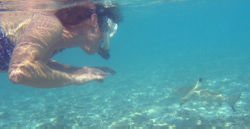
Sharks rarely attack humans unless provoked. In 2006 the International Shark Attack File (ISAF) undertook an investigation into 96 alleged shark attacks, confirming 62 of them as unprovoked attacks and 16 as provoked attacks. The average number of fatalities per year between 2001 and 2006 from unprovoked shark attacks is 4.3.
Contrary to popular belief, only a few sharks are dangerous to humans. Out of more than 360 species, only four have been involved in a significant number of fatal, unprovoked attacks on humans: the great white, oceanic whitetip, tiger, and bull sharks. These sharks, being large, powerful predators, may sometimes attack and kill people, but all of these sharks have been filmed in open water, without the use of a protective cage.
The perception of sharks as dangerous animals has been popularised by publicity given to a few isolated unprovoked attacks, such as the Jersey Shore shark attacks of 1916, and through popular fictional works about shark attacks, such as the Jaws film series. The author of Jaws, Peter Benchley, had in his later years attempted to dispel the image of sharks as man-eating monsters.
Sharks in captivity

Until recently only a few benthic species of shark, such as hornsharks, leopard sharks and catsharks could survive in aquarium conditions for up to a year or more. This gave rise to the belief that sharks, as well as being difficult to capture and transport, were difficult to care for. A better knowledge of sharks has led to more species (including the large pelagic sharks) being able to be kept for far longer. At the same time, transportation techniques have improved and now provide a way for the long distance movement of sharks. The only species of shark to have never been successfully held in captivity was the great white, until September 2004 when the Monterey Bay Aquarium successfully kept a young female great white shark for 198 days before releasing her back into the wild.
Despite being considered critical for the health of the shark, very few studies on feeding have been carried out. Since food is the reward for appropriate behaviour, trainers must rely on control of feeding motivation.
Conservation
The majority of shark fisheries around the globe have little monitoring or management. With the rise in demand of shark products there is a greater pressure on fisheries. Stocks decline and collapse because sharks are long-lived apex predators with comparatively small populations, which makes it difficult for them breed rapidly enough to maintain population levels. Major declines in shark stocks have been recorded in recent years - some species have been depleted by over 90% over the past 20-30 years with a population decline of 70% not being unusual. Many governments and the UN have acknowledged the need for shark fisheries management, but due to the low economic value of shark fisheries, the small volumes of products produced and the poor public image of sharks, little progress has been made.
Many other threats to sharks include habitat alteration, damage and loss from coastal developments, pollution and the impact of fisheries on the seabed and prey species.
A Canadian-made documentary, Sharkwater is raising awareness of the depletion of the world's shark population.
Shark fishery

An estimate states that, every year, 26 to 73 million (median value is at 38 million) sharks are killed by people in commercial and recreational fishing. In the past, sharks were killed simply for the sport of landing a good fighting fish (such as the shortfin mako sharks). Shark skin is covered with dermal denticles, which are similar to tiny teeth, and was used for purposes similar to sandpaper. Other sharks are hunted for food (Atlantic thresher, shortfin mako and others), and some species for other products.
Sharks are a common seafood in many places around the world, including Japan and Australia. In the Australian State of Victoria shark is the most commonly used fish in fish and chips, in which fillets are battered and deep-fried or crumbed and grilled and served alongside chips. When served in fish and chip shops, it is called flake. In India small sharks or baby sharks (called sora in Tamil language) are caught by fishermen routinely and are sold in the local markets. Since the flesh is not developed completely it just breaks into powder once boiled and this is then fried in oil and spices (called sora puttu). Even the bones are soft and these can be easily chewed and considered a delicacy in coastal Tamil Nadu. In Iceland, Greenland sharks are fished to produce hákarl or fermented shark, which is widely regarded as a national dish.
Sharks are often killed for shark fin soup: the finning process involves the removal of the fin with a hot metal blade. Fishermen will capture live sharks, fin them, and release the finless animal back into the water. The immobile shark soon dies from suffocation or predators. Despite claims that this practice is rare, it has become a major trade within black markets all over the world with shark fins going at about $220/ lbs. Millions of sharks a year are being illegally poached for their fins and not many governments are enforcing the laws of protecting these apex predators. The dish is considered a status symbol in Asian countries, and is considered healthy and full of nutrients, with some even claiming they prevent cancer and other ailments. There is no scientific proof that supports these claims; at least one study has shown shark cartilage of no value in cancer treatment. The shark fin trade is a major problem and has gained international controversy.
Sharks are also killed for their meat. Conservationists have campaigned for changes in the law to make finning illegal in the U.S. The meat of dogfishes, smoothhounds, catsharks, makos, porbeagle and also skates and rays are in high demand by European consumers. However, the U.S. FDA lists sharks as one of four fish (with swordfish, king mackerel, and tilefish,) that children and women who are or may be pregnant should refrain from eating. For details see mercury poisoning.
Shark cartilage has been advocated as effective against cancer and for treatment of osteoarthritis. (This is because many people believe that sharks cannot get cancer and that taking it will prevent people from getting these diseases, which is untrue.) However, a trial by Mayo Clinic found no effect in advanced cancer patients.
Sharks generally reach sexual maturity slowly and produce very few offspring in comparison to other fish that are harvested. This has caused concern among biologists regarding the increase in effort applied to catching sharks over time, and many species are considered to be threatened.
Some organizations, such as the Shark Trust, campaign to limit shark fishing. According to Seafood Watch, sharks are currently on the list of fish that American consumers, who are sustainability minded, should avoid.
Sharks in mythology
Sharks figure prominently in the Hawaiian mythology. There are stories of shark men who have shark jaws on their back. They could change form between shark and human at any time they desired. A common theme in the stories was that the shark men would warn beach-goers that sharks were in the waters. The beach-goers would laugh and ignore the warnings and go swimming, subsequently being eaten by the same shark man who warned them not to enter the water.
Hawaiian mythology also contained many shark gods. They believed that sharks were guardians of the sea, and called them Aumakua:
- Kamohoali'i - The best known and revered of the shark gods, he was the older and favoured brother of Pele, and helped and journeyed with her to Hawaii. He was able to take on all human and fish forms. A summit cliff on the crater of Kilauea is considered to be one of his most sacred spots. At one point he had a heiau (temple or shrine) dedicated to him on every piece of land that jutted into the ocean on the island of Moloka'i.
- Ka'ahupahau - This goddess was born human, with her defining characteristic being her red hair. She was later transformed into shark form and was believed to protect the people who lived on O'ahu from sharks. She was also believed to live near Pearl Harbour.
- Kaholia Kane - This was the shark god of the ali'i Kalaniopu'u and he was believed to live in a cave at Puhi, Kaua'i.
- Kane'ae - The shark goddess who transformed into a human in order to experience the joy of dancing.
- Kane'apua - Most commonly, he was the brother of Pele and Kamohoali'i. He was a trickster god who performed many heroic feats, including the calming of two legendary colliding hills that destroyed canoes trying to pass between.
- Kawelomahamahai'a - Another human, he was transformed into a shark.
- Keali'ikau 'o Ka'u - He was the cousin of Pele and son of Kua. He was called the protector of the Ka'u people. He had an affair with a human girl, who gave birth to a helpful green shark.
- Kua - This was the main shark god of the people of Ka'u, and believed to be their ancestor.
- Kuhaimoana - He was the brother of Pele and lived in the Ka'ula islet. He was said to be 30 fathoms (55 m) long and was the husband of Ka'ahupahau.
- Kauhuhu - He was a fierce king shark that lived in a cave in Kipahulu on the island of Maui. He sometimes moved to another cave on the windward side of island of Moloka'i.
- Kane-i-kokala - A kind shark god that saved shipwrecked people by taking them to shore. The people who worshipped him feared to eat, touch or cross the smoke of the kokala, his sacred fish.
In other Pacific Ocean cultures, Dakuwanga was a shark god who was the eater of lost souls.
Sharks in cultural tradition
In ancient Greece, it was forbidden to eat shark flesh at women's festivals.
A popular myth is that sharks are immune to disease and cancer; however, this is untrue. There are both diseases and parasites that affect sharks. The evidence that sharks are at least resistant to cancer and disease is mostly anecdotal and there have been few, if any, scientific or statistical studies that have shown sharks to have heightened immunity to disease.
In popular culture
Films
- 20,000 Leagues Under The Sea (1954)
- Thunderball (1965)
- Blue Water, White Death (1971)
- Jaws series (1975, 1978, 1983, 1987)
- Live and Let Die (1973)
- The Spy Who Loved Me (1977)
- Tintorera (1977)
- Great White (1980)
- Licence To Kill (1989)
- Cruel Jaws (1995)
- Deep Blue Sea (1999)
- Shark Attack series (1999, 2001, 2002)
- The Beach (2000)
- Pinocchio (2002)
- Open Water series (2003, 2007)
- Red Water (2003)
- Finding Nemo (2003)
- Shark Tale (2004)
- The Life Aquatic with Steve Zissou (2004)
- The Twelve Days of Terror (2004)
- Megalodon (2004)
- Into the Blue (2005)
- Spring Break Shark Attack (2005)
- Shark Bait (2006)
- Sharkwater (2007)
Television
- Street Sharks (1994-1995)
- 12 oz. Mouse (2005-2007)
- Jabberjaw (1976-1978)
Books
- The Adventures of Pinocchio (1883)
- The Old Man and the Sea Ernest Hemingway (1952)
- Jaws Peter Benchley (1974)
- Megalodon Robin Brown (1983)
- Deep Wizardry Diane Duane (1985)
- Carcharodon George Edward Noe (1987)
- Meg: A Novel of Deep Terror Steve Alten (1997)
- The Trench Steve Alten (1999)
- Meg: Primal Waters Steve Alten (2004)
